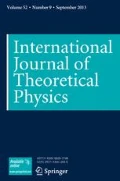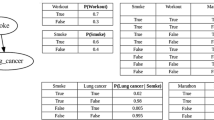Abstract
This work aims to develop a novel BDI agent programming framework, which embeds the reasoning under uncertainty (probabilistic logic) and is capable of a realistic simulation of human reasoning. We claim that such a development can be addressed through the adoption of the mathematical and logical formalism derived from Quantum Mechanics: a scheme fulfilling the necessary requirements is described, useful for both the interpretation of some peculiarities in human behavior, and eventually the adoption of ‘quantum computing’ formalism for the agent programming. This last possibility could exploit the power of quantum parallelism in practical reasoning applications. Integration with the BDI paradigm enables the straightforward adoption of efficient learning algorithms and procedures, enhancing the behavior and adaptation of the agent to the environment.

Similar content being viewed by others
Notes
Also known as BWI: ‘Belief-Wish-Intentions’
In the following, with the word cognitive, we will refer in general to the ensemble of learning, training and reasoning processes.
E.g. a robot’s sensor, able to measure the external temperature, permits the robot to have a belief about the real, current value of this variable. If the sensor’s reading is 50 ∘C, one can not infer that this is certainly the actual value: the sensor may be out-of-service.
It is possible to extend the formalism developed to the case of continuous variables, but this poses some difficulties which prevent a straightforward extension.
I.e. its mental state, according to its beliefs, at a certain moment of the reasoning.
This characterization descends from describing these states as Hilbert space basis vectors: if one is certainly TRUE, than all the others must be FALS E.
It is skipped here the particular case of a pure separable global state, represented by a diagonal density operator, as it can be reduced to the trivial case where the density matrix in (14) has only one non-vanishing diagonal element, i.e. the global state is an eigenstate of the global density matrix. All other considerations done for Example 1 would nevertheless hold for this specific case.
It is worth to briefly comment also the more general case where the global density matrix is separable as \({\rho }_{MS}= {\sum }_{i} \lambda _{i} {\rho }_{i(B)} \otimes {\rho }_{i(I)}\). Here correlations among the subsystems are expected; nevertheless, for this case it would be still possible to describe two-system probabilities as classical probabilities [35].
Notice ho w the reduced density matrix ρ (I), given the separability outlined, coincides with the term in the product of (15).
I.e. the only information supposed directly accessible.
Which is the same as a change in the basis used for ρ (B).
Indeed, an agent requires near real-time decision-making.
References
Khrennikov, A.: Ubiquitous Quantum Structure. Springer (2010)
Aerts, D., Aerts, S.: Applications of quantum statistics in psychological studies of decision processes. Top. Found. Stat., 85–97 (1997)
Busemeyer, J.R., Bruza, P.D.: Quantum Models of Cognition and Decision. Cambridge University Press (2012)
Aerts, D., Sozzo, S., Tapia, J.: A quantum model for the Ellsberg and Machina paradoxes, pp 48–59. Springer (2012)
Busemeyer, J.R., Wang, Z., Lambert-Mogiliansky, A.: Empirical comparison of Markov and quantum models of decision making. J. Math. Psychol. 53(5), 423–433 (2009)
Aerts, D.: Quantum structure in cognition. J. Math. Psychol. 53(5), 314–348 (2009)
Piotrowski, E.W., Sladkowski, J.: An invitation to quantum game theory. Int. J. Theor. Phys. 42(5), 1089–1099 (2003)
Trueblood, J.S., Busemeyer, J.R.: A quantum probability account of order effects in inference. Cogn. Sci. 35(8), 1518–1552 (2011)
Aerts, D., Broekaert, J., Smets, S.: The Liar-paradox in a quantum mechanical perspective. Found. Sci. 4(2), 115–132 (1999)
Acacio de Barros, J., Suppes, P.: Quantum mechanics, interference, and the brain. J. Math. Psychol. 53(5), 306–313 (2009)
van Rijsbergen, C.J., The Geometry of Information Retrieval. Cambridge University Press (2004)
Aerts, D., Czachor, M.: Quantum aspects of semantic analysis and symbolic artificial intelligence. J. Phys. A 37, L123–L132 (2004)
Amann, A.: The Gestalt problem in quantum theory: generation of molecular shape by the environment. Synthese 97(1), 125–156 (1993)
Conte, E., et al.: Mental states follow quantum mechanics during perception and cognition of ambiguous figures. Open Syst. Inf. Dyn. 16(1), 85–100 (2009)
Choustova, O.A.: Quantum Bohmian model for financial market. Phys. A Stat. Mech. Appl. 374(1), 304–314 (2007)
Khrennikov, A.Y., Haven, E.: Quantum Social Science. Cambridge University Press (2013)
van Dam, K.H., Nikolic, I., Lukszo, Z. : Agent-based Modelling of Socio-technical Systems. Springer (2012)
Gilbert, N.: Agent-based models. Sage (2008)
Georgeff, M., et al.: The Belief-Desire-Intention model of agency. In: Proceedings of the conference Agents, Theories, Architectures and Languages (1999)
Farias, G.P., Dimuro, G.P., Rocha Costa, A.C.: BDI Agents with fuzzy perception for simulating decision making in environments with imperfect information. MALLOW-2010 (2010)
Chen, M., Jiaotong, L., Hu, X.: Using Fuzzy Logic as a Reasoning Model for BDI Agents. In: International Conference on Computational Intelligence and Software Engineering (CiSE) (2010)
Shen, S., Ohare, G.M.P., Collier, R.: Decision-making of BDI agents: a fuzzy approach. In: Proceedings of the 4 th International Conference on Computer and Information Technology (CIT2004) (2004)
Brown, S.M., Santos, Jr. E., Banks, S.B.: A dynamic Bayesian intelligent interface agent. In: Proceedings of the 6 th International Interfaces Conference, pp. 118–120 (1997)
Poole, D., Mackworth, A.: Artificial Intelligence. Cambridge University Press (2010)
Fagundes, M.S., Vicari, R.M., Coelho, H.: Deliberation process in a BDI model with Bayesian networks, Agent Computing and Multi-Agent Systems, pp 207–218. Springer (2009)
Aldrich, J.H., Nelson, F.D.: Linear probability, logit, and probit models. SAGE (1984)
Anderson, E.: Modern Physics and Quantum Mechanics (1971)
Yukalov, V.I., Sornette, D.: Quantum decision making by social agent. arXiv:1202.4918 (2012)
Yukalov, V.I., Sornette, D.: Decision theory with prospect interference and entanglement. arXiv:1102.2738 (2012)
Tucci, R.R.: Quantum Bayesian Nets. Int. J. Mod. Phys. B9, 295–337 (1995)
Tucci, R.R. (2012)
Tucc, R.R.: How to compile a quantum Bayesian Net. arXiv:quatum-ph/9805016 (2012)
Bishop, C.M.: Pattern Recognition and Machine Learning. Springer, New York (2006)
Jauch, J.M.: Foundations of Quantum Mechanics. Addison-Wesley Publishing (1968)
Mintert, F., et al.: Measures and dynamics of entangled states. Phys. Rep. 415(4), 207–259 (2005)
Gottfried, K., Tung-Mow, Y.: Quantum mechanics: fundamentals. Springer (2003)
Blum, K.: Density Matrix Theory and Applications. Springer (2012)
Birkhoff, G., von Neumann, J.: The logic of quantum mechanics. Ann. Math. 37, 823–843 (1936)
Mittelstaedt, P.: Quantum logic. vol. 126 of Synthese Library (1978)
Mateus, P., Sernadas, A.: Exogenous quantum logic. In: Proceedings of CombLog04 (2004)
Meyden, Ron Van Der, Patra, M.: A logic for probability in quantum systems. In: Proceedings of the Computer Science Logic and 8th Kurt Godel Colloquium, pp. 427–440 (2003)
van der Meyden, R., Patra, M.: Knowledge in quantum systems. In: Proceedings of the Conference on Theoretical Aspects of Knowledge and Rationality, pp. 104 –117 (2003)
Author information
Authors and Affiliations
Corresponding author
Rights and permissions
About this article
Cite this article
Bisconti, C., Corallo, A., Fortunato, L. et al. A Quantum-BDI Model for Information Processing and Decision Making. Int J Theor Phys 54, 710–726 (2015). https://doi.org/10.1007/s10773-014-2263-x
Received:
Accepted:
Published:
Issue Date:
DOI: https://doi.org/10.1007/s10773-014-2263-x




